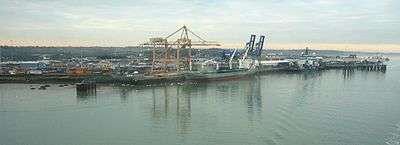HMS Badger (shore establishment)
 Harwich International Port, a present-day view of the site of HMS Badger | |
| History | |
|---|---|
| Name: | HMS Badger |
| Commissioned: | 13 September 1939 |
| Decommissioned: | 21 October 1946 |
| General characteristics | |
| Class and type: | Stone frigate |
HMS Badger was commissioned on 13 September 1939 as the headquarters of the Flag Officer In Charge, Harwich and was decommissioned on 21 October 1946, although the Operations Room remained as the Emergency Port Control for the Harwich area. The site was Parkeston Quay, now Harwich International Port, and the bunker lies under Hamilton House, currently an occupational health centre, close to the entrance to Harwich International Port, a few miles west of Harwich.
World War II service
The Parkeston Quay site had been used during World War I by the Royal Navy, and an Admiralty Research Laboratory had been constructed there. The port was again requesitioned from the LNER at the beginning of World War II. In its early days Badger provided a base for minesweepers, but by the end of 1940 it also serviced a destroyer flotilla, a submarine squadron and a Coastal Forces motor torpedo boat base, becoming the largest base for small craft in the United Kingdom.[1]
After a short period accommodated in the Station Hotel at Parkeston Quay, the accommodation and administration moved in 1940 to Hamilton House, the former Georgian customs house. A bunker was built under Hamilton House, and this opened in 1941 as an underground operations room. Anti-aircraft sea-forts (known as HM Fort Roughs), located 10 miles offshore, were kept supplied from HMS Badger.[2] An alternative deceptive site for Parkeston Quay was sited at East Mersea,[1] but the port area suffered extensive damage from air attacks during the course of World War II [3]
Post-war service

HMS Badger was decommissioned on 21 October 1946, but the operations room was retained. When the Royal Naval Auxiliary Service (RNXS) was formed in 1964 the bunker was refurbished and re-opened as the emergency port control for Parkeston, Harwich, the Port of Felixstowe, the Port of Ipswich and the River Orwell. Several of these centres around the United Kingdom were intended to direct shipping in the event of a nuclear attack. The RNXS bunker remained operational until 1992.[1]
References
- 1 2 3 "RNXS Parkeston Quay at BunkerTours.co.uk.". Retrieved 2008-07-18.
- ↑ "The Rough Towers at HarwichSociety.co.uk". Retrieved 2008-07-18.
- ↑ "Harwich International Port Information". Retrieved 2008-07-18.
External links
Coordinates: 51°56′53″N 1°15′18″E / 51.948°N 1.255°E